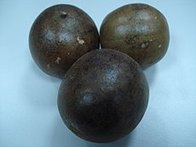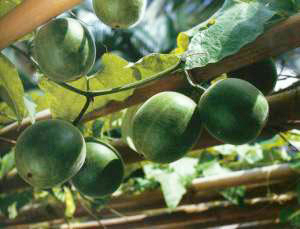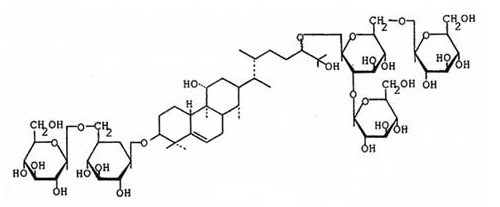|
|
Monk’sFruit/ Luohanguo (Siraitia grosvenori )
Sweet Fruit Used as Sugar Substitute and Medicinal Herb
|
| Siraitia grosvenori |
|
 |
| |
|
| Common Name: luohan guo/ Monk’s fruits |
| Binomial name: Siraitia grosvenorii |
Scientific classification
Kingdom: Plantae
Division: Magnoliophyta
Class: Magnoliopsida
Order: Violales
Family: Cucurbitaceae
Subfamily: Cucurbitoideae
Tribe: Joliffieae
Subtribe: Thladianthinae
Genus: Siraitia Merr.
Species: S. grosvenorii
Molecular Weight:1287.43
Molecular Structure
|
Suggested Applications:
1. Powerful antioxidant function.
2. To relieve cough and expectorant.
3. To improve immunity.
4. To lower the blood sugar.
5. To protect liver.
6. To anti-cancer.
7. To restrain dental caries lead by ingbritt.
|
Applicable Industries:
Medicine, Functional Food, Beverage & Food |
Microbiological Control:
Total Plate Count: less than 1000CFU/g
Yeast & Mold: less than 100CFU/g
E.Coli: Negative
Salmonella: Negative
|
|
| |
|
Monk’Fruit is also known as Luo Han Guo (luohanguo) refers to the fruit of Siraitia grosvenori, formerly called Momordica grosvenori, a member of the Curcubitaceae (1). The fruit is well-known for its sweet taste.The sweatness of this fruit is due to the presence of achemical mogrosidein its pulp. Mogroside is 300 times sweater than sugar the pulp of this fruit contains around 1% mogroside making it the sweatest fruit on earth.; this plant family (Gourd family) has other members that contain remarkable sweet components, including additional species of the genus Siraitia (e.g., S. siamensis, S. silomaradjae, S. sikkimensis, S. africana, S. borneensis, and S. taiwaniana 2) and the popular herb jiaogulan (Gynostemma pentaphyllum). The latter herb, which has both sweet and bitter tasting triterpene glycosides in its leaves, is now sold worldwide as a tea and made into an extract for use in numerous health-care products (3). Luohanguo has been used as a medicinal herb for treating cough and sore throat (4) and is popularly considered, in southern China, to be a longevity aid (5). These are the same uses as listed for jiaogulan. Luohanguo has more recently been developed into a non-caloric sweetener to compete with other herbal sweeteners such stevioside from the unrelated Stevia leaf. Cultivation
Monk’fruit (Luohanguo) is primarily grown in southern China, mainly in Guangxi Province, with most of the product from the mountains of Guilin. The steep mountains provide shade and they are frequently surrounded by mists that further protect against excessive sun, yet the temperature in this southern province is warm. The wild plant is rare, thus luohanguo has been cultivated in the region for many years. There are descriptions of its cultivation in the area dating back to 1813 (5). Guilin now has a 4,000-acre luohanguo growing area that produces 10,000 pieces of fruit annually. With the time,the plant also travelled to a few more countries in the South –East Ashia.but most parts of the world are still unaware of it. In fact the world came to know about this fruit barely a hundred years ago.
This crop belongs to cucurbitaceous family like lauki and kaddu . The climatic conditions and cultural practices are the same as cucubitaceae plants. Monk fruit is however a perennial plant and not a seasonal vine like its Indian relatives. The cultivation of this crop is possible in north India. being a climber it requires support to grow. The vine reaches the height of 3-5 meters. It has 10-20 cm long, narrow, heart shape leaves, and the yellow flowers are somewhat atypical in shape for a cucurbit. Soak seed overnight in warm water. Sow in spring. Provide trellis. Traditional agricultural methods call for some shade in the cultivation of this unusual gourd.
The vine is vigorous grower and prolific bearer. However for getting optimum yield it has to be given right kind of support and made to grown on trellis or bowers. The plant life span of 5-7 years. The cultivation is simple and does not require specialized skill. The fruits of this crop are round, measuring 5-7 cm.The fruits are green in the beginning but turn slightly brown by maturity.Each fruit contains numerous seeds.the fruits can not be eaten fresh nor can it be kept for long since it starts rotting very soon. So after harvest it is dried slowly in the oven. It turns black after drying . the fruit is sold in shops only in that form.
(Luohanguo is collected as a round green fruit that turns brown upon drying. The sweet taste of luohanguo comes primarily from mogrosides, a group of terpene glycosides, present at the level of about 1% of the fleshy  part of the fruit (10). Both the fresh and dried fruits are extracted to yield a powder that is 80% or more mogrosides. The mogrosides have been numbered, 1-5, and the main component is called mogroside-5, previously known as esgoside (see chemical structure diagram below). Other, similar compounds from luohanguo have been labeled siamenoside and neomogroside. The mixed mogrosides are estimated to be about 300 times as sweet as sugar by weight, so that the 80% extracts are nearly 250 times sweeter than sugar; pure mogrosides 4 and 5 may be 400 times as sweet as sugar by weight. part of the fruit (10). Both the fresh and dried fruits are extracted to yield a powder that is 80% or more mogrosides. The mogrosides have been numbered, 1-5, and the main component is called mogroside-5, previously known as esgoside (see chemical structure diagram below). Other, similar compounds from luohanguo have been labeled siamenoside and neomogroside. The mixed mogrosides are estimated to be about 300 times as sweet as sugar by weight, so that the 80% extracts are nearly 250 times sweeter than sugar; pure mogrosides 4 and 5 may be 400 times as sweet as sugar by weight.

HISTORY AND TRADITION
The herb became more prominent during the 20th century. One early English-language report on it is an unpublished manuscript written in 1938 by Professor G.W. Groff and Hoh Hin Cheung (11). The fruits were reported to be frequently used as the main ingredient in cooling drinks (that is, drinks consumed to counteract hot weather, fever, or disorders described in the tradition as warm or hot in nature). The juice of fresh fruits was known to be very sweet. Groff and Hoh noted that the "luohan fruit of commerce, when cooked with pork or steeped with tea, provides a common Chinese household remedy for colds and congestion of the lungs." They confirmed through interviews that the fruit had only become extensively used in China in recent history. Still, it appears that the development of distinct cultivars and extensive knowledge of its growth, pollination, and climatic requirements implies a fairly long history of cultivation activity by at least a limited group of people.
The herb had been brought to the U.S. early in the 20th century. Groff mentions that during a 1917 visit to the U.S. Department of Agriculture, botanist Frederick Coville showed him a luohan fruit obtained from a local Chinese store in Washington, DC. Seeds from luohan fruits purchased in a San Francisco Chinese store were included in the original botanical description of the species in 1941.
The beginning of research into the sweet component of luohanguo is attributed to C.H. Lee, who published an English report in 1975 (12), and to Tsunematsu Takemoto working in Japan in the early 1980s (he later turned his attention to studying jiaogulan
(3). Development of luohanguo products in China has grown steadily since that time, particularly with the more recent development of highly concentrated extracts for use as sweeteners.
Probably the best depiction of luohanguo medicinal use in southern China during the 20th century is that given by Dai and Liu in their book Fruit as Medicine
(4), originally published in Chinese in 1982, then published in English in 1986. Here is their description:
Dried fruit may be bought in the city markets. The outer surface of the dried fruit is round and smooth, dusty yellow-brown or dusty green-brown. It is covered with fine, soft hair. The fruit is covered by a hard but thin shell. Inside is a partly dry, flexible substance containing the juice, as well as a large number of seeds. The skin, juicy part, and seeds all have a good sweet flavor. Its nature is cool, and it has no poison. The fruit helps relieve sunstroke, moistens the lungs, eliminates phlegm, stops cough, and promotes bowel movements.
Applications:
-
Heat stroke with thirst: Take one fruit, break it open and stir into boiled water. Drink the liquid in place of tea.
-
Acute or chronic throat inflammation; aphonia. Take half a fruit and 3-5 seeds of sterculia. Cover with water and simmer, and then swallow very slowly.
-
Chronic cough. Take 1 piece of fruit, cover with water, simmer, and drink the liquid. Do this twice each day.
-
Constipation in the aged. Take 2 pieces of fruit, obtain the juicy part and the seed (put the shell aside for other uses), break apart, cover with water, and simmer. Drink before going to bed.
Diabetes. Take an appropriate measure of the fruit and crush it or simmer it into a thick juice and add to food being prepared, using it as a substitute for sugar.
Numerous other products are now made with luohanguo, alone or, more commonly, with other herbs. Below are some samples of such products in tea form.
Recent work on luohanguo includes investigation of the antioxidant activity of the mogrosides (13) and their potential use as cancer prevention compounds (14). This suggested effect is based on the understanding that antioxidants can produce significant reversal or suppression of the early stage of cancer development, which has been an area of particular interest for tea drinking (15). Further, luohanguo and its sweetening component are often mentioned in relation to diabetes and obesity, because it can substitute for caloric sugars normally consumed in the diet
Siraitia grosvenorii extract
Latin Name: Momordica Grosvenori Swingle
Botanical Source: Momordica
Part Used: Fruit
Appearance: Light yellow fine powder.
Active Ingredient: Mogrosides
Specification: Mogrosides:80%
Test Method: UV
Molecular Formula: C60H102O29
|
(Siraitia grosvenori, grosvenorii) (Luo-han-guo)
Family: Cucumber (Cucurbitaceae)
Hardiness: about 20 degrees F.
Perennial dioecious vine native to southwestern China. Cultivated in northern Kwangsi by the Miao-tze peoples who grow it in the mountain forests. Rare in these parts, and one of the most desired cucurbits among collectors. Like ginseng, this is one of the chinese herbs that tonifies the yin. Household remedy for treating upper respiratory infection and gastric upset. The medicine consists of the dried fruits. The entire plant is gently pubescent, and the fruits are densely covered in down, ovoid or rounded and extremely sweet. The leaves are somewhat heart shaped and entire, and the yellow flowers are somewhat atypical in shape for a cucurbit. Soak seed overnight in warm water. Sow in spring, in rich hills in the garden. Provide trellis. Traditional agricultural methods call for some shade in the cultivation of this unusual gourd, and cool/foggy conditions are well-tolerated.
The other species of the genus Siraitia are S. siamensis from Thailand, S. sikkimensis and S. silomaradjae from India, and S. taiwaniana from the Republic of China .
The vine grows to 3 to 5 m long, climbing over other plants by means of tendrils which twine round anything they touch. The narrow, heart-shaped leaves are 10 20 ;cm long. The fruit is globose, 5 7 ;cm in diameter, and contains a sweet, fleshy, edible pulp and numerous seeds.
The fruit extract is nearly 300 times sweeter than sugar and has been used as a natural sweetener in China for nearly a millennium due to its flavor and lack of food energy, only 230 kcal 100g compared to granulated sugar which has 387 kcal 100g. It has also been used in traditional Chinese medicine.
|
| |
|
|